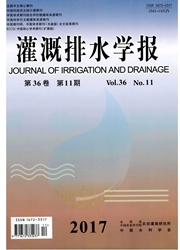

 中文摘要:
中文摘要:
在湖北省鄂州节水示范基地展开试验研究,利用LPS—05型植物生长检测仪对温室番茄的生理状况及室内环境进行实时监测。定性分析番茄主要器官(茎、叶)对室内温湿环境所响应的微动态变化,以作物自身生理状况为参考标准,确定了适宜番茄生长的温室环境指标。番茄茎粗生长最优的临界夜间最低温度为17.8℃;2类典型天气条件下叶表面露水汽化时间分别为09:30(晴)和11:30(阴雨),均比空气滞后1h;在充分灌水条件下,温室番茄发生水分胁迫时空气饱和水汽压差的临界值约为2.7kPa。
 英文摘要:
英文摘要:
There are great changes between the crop growth environment inside and outside the greenhouse. In order to achieve the purpose of reasonable control on greenhouse crop growth environment, afield experimental research on seeking optimum environment management indicators for greenhouse tomato was taken in E-Zhou water-saving irrigation experiment station, Hubei province in China. In the measurement, a phytomonitor for plants (No- LPS- 05) was used for a real-time monitoring crop physiological parameters and environmental parameters. Through the qualitative analysis of micro dynamic responses of tomato major organs (stem, leaves) to the related changes of indoor temperature and humidity environment, the appropriate environment management standards for greenhouse tomato growth were confirmed: (1)the optimal critical minimum temperature at night for tomato stem diameter growth was 17.8 ℃ (2)the leaf surface vaporization happened respectively at 09.30 (fine day) and 11-30 (rain day), lagging one hour than air vaporization in the two kinds of typical weather conditions (3)On the premise of enough soil moisture, "2.7 kPa" was the critical value of saturation vapor pressure difference, which could lead to greenhouse tomato water stress.
 同期刊论文项目
同期刊论文项目
 同项目期刊论文
同项目期刊论文
 期刊信息
期刊信息
